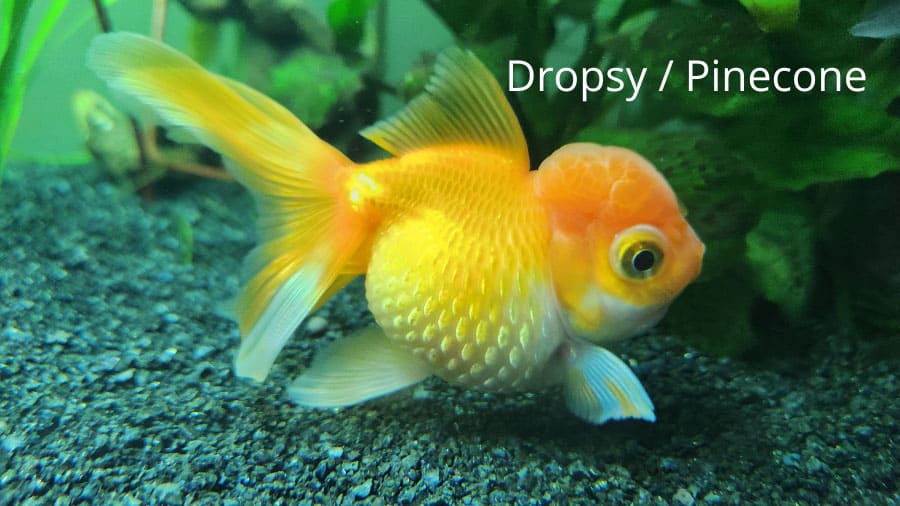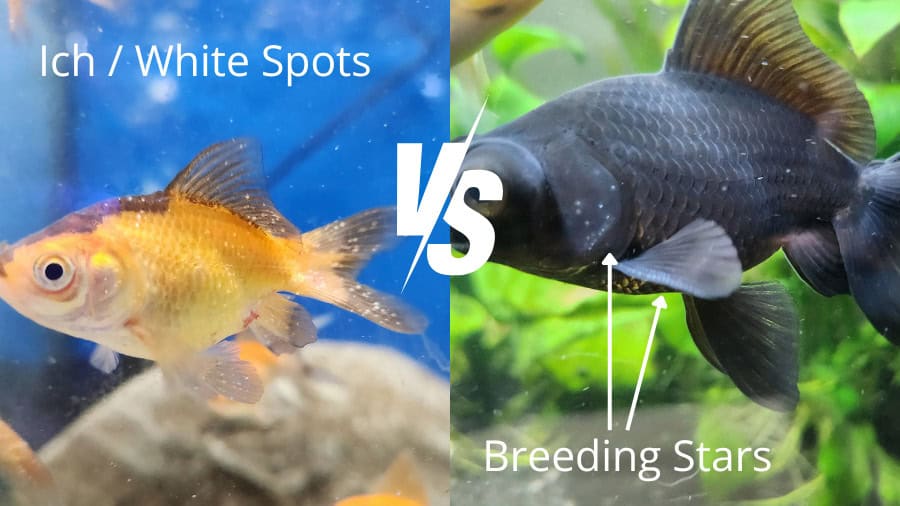Common Freshwater Fish Diseases (Symptoms And Treatments)
We can be careful to avoid any diseases in our tank, but eventually, we will experience one. Here, I will provide you with checklists so you can make sure you can diagnose your freshwater fish sooner rather than later.
Luckily, with all the information at our fingertips and our local pet shops stocking all the necessary medicine, we can treat our beloved fishies and get them feeling better quickly.

| Symptoms | Disease | Treatment |
| White, salt grain-type spots on skin and fins. Rubbing and scratching against hardscapes/substrate | White Spot / Ich * See note below | White Spot Treatment (Anti White Spot Plus/Seachem MetroPlex) Follow the dosage for your tank or hospital tank. |
| Yellowish dust-like tiny spots on skin and fins. Rubbing and scratching against hardscapes/substrate | Velvet | Velvet Disease Treatment (API General Cure & Aquarium Salt) Follow the dosage for your tank or hospital tank. |
| Split fins with blood streaks | Fin Rot | Broad Spectrum Antibiotic (API Melafix) Follow the dosage for your tank or hospital tank. |
| White-looking growths in or around the mouth | Mouth Fungus Usually caused by Fin Rot | Broad Spectrum Antibiotic (API Melafix) Follow the dosage for your tank or hospital tank. |
| Cottonwool-like growth on skin and fins | Fungus | Fungus Treatment (API Pimafix Anti Fungal) Follow the dosage for your tank or hospital tank. |
| Floating/Sinking and overall buoyancy problems | Swim Bladder Common among round-body fancy goldfish * See note below | Raise the water temperature slightly, starve fish for three days, and incorporate raw garlic and peas into the diet. |
| Excessive mucus production on gills or body, inflamed spots on body and fins, rubbing and scratching against hardscapes/substrate | Skin/Gill/Body Flukes | Fluke Treatment (Waterlife Sterazin gill and body flukes): Get the proper medication for your fish and tank, as some contain copper. |
| Eyes protruding, loss of condition, erratic behavior, shimmying (side-to-side movements) | Pop-eye | Remove 25% of the tank water and add new water, including dechlorination drops and Seachem KanaPlex Treatment. Full check on the environment (pH, Ammonia, Copper, temperature, diet, etc) *See the Water Quality Conditions Table below |
| Hard, waxy, whitish/cream patches on skin and fins | Fish Pox Common among Cold Water Carps | Not Fatal Treatment like ParaCleanse can be used to speed treatment along but usually goes away on its own |
| Boils, ulcers, red spots, wasting away, a hole in the head or body | Bacterial Infection | Broad Spectrum Antibiotics Treatment (Seachem MetroPlex / NeoPlex) Follow the dosage for your tank or hospital tank. |
| Bloating/Looks pregnant, lethargic, loss of appetite, raised scales looking like a “pine cone” | Dropsy / Pinecone | There is no cure, but if caught early enough, Seachem KanaPlex can be used as a possible treatment. |
| Flat, circular, mobile parasites that get up to 1CM long on body and fins of fish | Fish Louse Argulus | Argulus Treatment (Masoten Antiparasitic) Follow the dosage for your tank or hospital tank. |
| Long, thin, white worm-like parasite on body or fins up to 2CM long | Anchor Worm Lernaea | Anchor Worm Treatment (MICROBE-LIFT Lice & Anchor Worm) |
| Bloated abdomen, raised scales, loss of condition. Death can occur within hours or a few days. | Malawi Bloat Common among African Cichlids | No cure is available, but changes in diet, water conditions, and reduction in stress can be effective preventatives |
*White Spot Disease / Ich covers the entire fish and is sometimes, especially in the beginning, confused with breeding stars that your male fish might start showing when he is mature. Please note copper sulfate is usually found in these medications. This could kill your tank’s snails, shrimps, and other scaleless fish.

*Swim Bladder is a managed disease and not something you can cure completely. I make sure to feed my Fancy Goldish their flakes by submerging the flakes in the water. This stops them from coming to the surface and gulping air with their food and does assist with their buoyancy.
Aquarium Fish Environmental Conditions (Water Quality)
| Cause | Symptoms | Prevention And Treatment |
| Chlorine | Loss of balance and appears restless with movements | Remove 25% of the tank water, add new water, including dechlorination drops, and aerate the water for 24 hours |
| Ammonia / Chloramine | Inflamed red gills and fin edges, blood spots can also be visible, and balance can be lost. | 1. Check the heater/thermostat. Increase the temperature gradually by replacing the tank water with warmer water and switching on the heater/thermostat. 2. Check the heater/thermostat and switch it off. Gradually decrease the temperature by replacing the tank water with room-temperature water and switching on the heater/thermostat once the desired temperature is reached. |
| Metallic Ions | Gasping at the surface, inflamed/clumped gill filaments | Remove 25% of the tank water and add new water, including dechlorination drops and conditioning for tap water |
| *Oxygen / Nitrogen | 1. Excess: Gas Bubble Disease causes tiny bubbles visible under the skin, in the fins, and around the head and eyes; Exophthalmia (Pop-eye) 2. Insufficient Oxygen: Gasping at the surface, some loss of color | 1. Decrease airstone or additional aeration or decrease the number of plants. Don’t drastically decrease oxygen levels; do it gradually. 2. Remove 25% of the tank water and add new water, including dechlorination drops and additional aeration. |
| pH | 1. Acidosis Fast swimming movements, gasping at the surface or trying to jump out of the water OR extreme sluggishness, hiding and loss of color and appetite 2. Alkalosis Damage to gills, disintegrated fin edges, and general opaque-looking skin | 1. Avoid fish overstocking and plant understocking. Remove 25% of the tank water and add new water, including dechlorination drops and appropriate pH adjusters. 2. Heavily planted tanks need to reduce prolonged light exposure. Remove 25% of the tank water and add new water, including dechlorination drops and appropriate pH adjusters. |
| Fumes / Sprays | Gasping at the surface, inflamed/clumped gill filaments | Ventilate room. Remove 25% of the tank water, add new water, including dechlorination drops, and switch off additional aeration until the fumes have subsided. |
| Temperature | 1. Low: Sluggish movements, resting on the bottom of the tank, reduced movements of fins and gill cover, and some coloration loss. 2. High: Initial coloration difference (more intense), increased activity level, increased respiration, gasping at the surface. | 1. Check the heater/thermostat. Increase the temperature gradually by replacing the tank water with warmer water and switching on the heater/thermostat. 2. Check the heater/thermostat and switch it off. Gradually decrease the temperature by replacing the tank with room-temperature water and switching on the heater/thermostat once the desired temperature is reached. |

*Oxygen or Nitrogen excess can be caused by a heavily planted tank that gets a lot of light or sunlight. The plants will release oxygen due to the photosynthesis process. You can slowly add conditioned tap water, which will decrease the oxygen in the water slightly.
